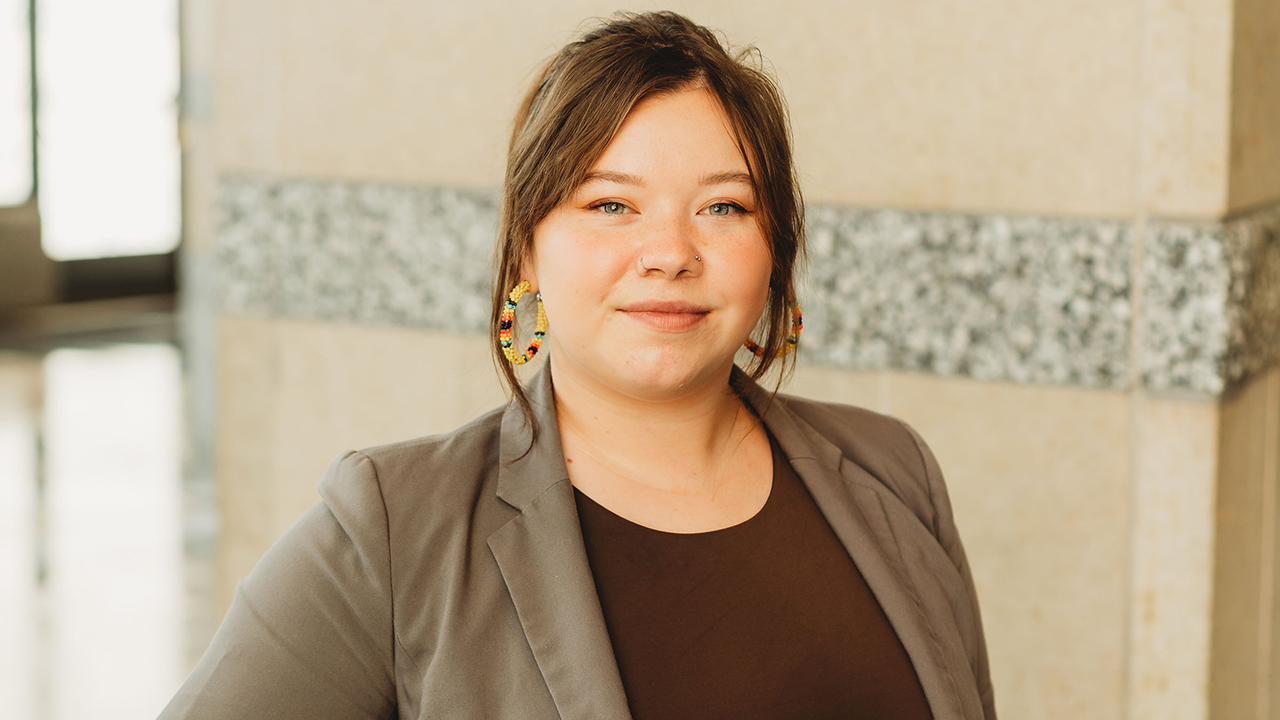
In celebration of Indigenous Peoples Month, Winona State University is sharing one Indigenous alum’s story of being at WSU. This continues WSU’s effort to uplift, validate, and magnify personal experiences of our historically marginalized students during heritage and history months throughout the year.
_____
Becoming a part of Winona State University’s community was a transformational experience for Regan Kluver ’19, an Indigenous alum from White Earth Nation.
It was at WSU where she found her calling to study History, to become an advocate, and she even found her future husband. It also brought her closer to her heritage by encouraging her to discover her roots.
“My growth in advocacy wouldn’t have been possible without my time at WSU,” said Kluver, who now runs the Native American Museum’s Undergraduate Fellowship Program at the Minnesota Historical Society.
But self-discovery and transformation didn’t happen overnight–especially when WSU still had work to do in being a welcoming place for Indigenous students.
When Kluver first got to WSU, her class orientation started in Somsen Hall back when the 1930’s -era mural of pioneers colonizing Winona was still visible. Now with removable panels that cover most of the mural, the painting depicts historically inaccurate accounts of the relationship between settlers and the Dakota people who inhabited the land. It also leaves out the atrocities suffered by the Indigenous people in being forcibly removed from their home.
“It was this glorified painting in the largest and most grandiose entryway on our campus,” Kluver said. “The mural and art were concerning for the safety of someone like me.”
But with the mural aside, Kluver began to find those on campus who became her support system during her time at WSU — whether it came from campus clubs, professors, or the fellow students she met.
Kluver got involved with the Turtle Island Student Organization (TISO), a club for Indigenous students to connect, support, and advocate together for Indigenous rights. She met Aaron Camacho, a fellow Indigenous student who became a dear friend and advocate for Indigenous rights and equity.
Around that same time, Kluver started to connect with her professors –, Dr. Colette Hyman and Mary Jo Klinker being among them.
Kluver’s classes gave her the opportunity to explore her passions and deepen her understanding, not only of the world around her, but also herself.
“I want to thank my History professors for encouraging me to explore my own history,” Kluver said during an Indigenous People’s Day speech at WSU.
She dedicated her college journey toward earning a bachelor’s degree in History.
With a supportive community and her newfound passion in History, Kluver began to push for change on campus.
Together, Camacho and Kluver– — alongside other members of the TISO club– — advocated for the removal of the End of the Trail Statue from an outdoor space on campus. Outside, the statue was often climbed on and was left without any context of what it was about. The group advocated for it to be relocated in the Darrell W. Krueger Library, where it now has a plaque with context on the piece.
Kluver and the TISO club were also the driving force behind building the Indigenous Learning Garden in the same location as where the End of the Trail Statue was.
“At times, it felt there was willingness ([from WSU leadership)] to take action steps for change,” Kluver said.
Through those experiences, Kluver learned how to speak up for what she believed was right. She learned how to navigate the complexities of a situation. And she learned how to celebrate the victories while also pushing for continued change.
After coming back to campus this year for Indigenous People’s Day, Kluver was surprised and happy to see that there’s been continued movement toward honoring Indigenous history with the covering of the Somsen 1930’s mural, which happened after she graduated.
“We walked in and it was completely shrouded,” Kluver said. “My mom’s jaw dropped.”
Kluver said she walked away impressed, while also wondering what would come next.
“It’s a step in the right direction,” she said. “And now Winona State needs to imagine what comes next.”
One way to move forward, she said, is to continue partnerships that WSU has already fostered with Dakota artists, like Minneapolis-based artist Angela Two Stars, or consult with the Minnesota Historical Society’s Indian Advisory Committee to get guidance on how to reimagine or give better context to the mural.
For Indigenous students considering WSU, Kluver said to know that things are changing for the better and there is a community of allies at WSU that will be there to support students.
“I wouldn’t have had the wherewithal to go forward with my naming ceremony or begin learning the Ojibwe language had it not been for the grounding at WSU,” she said. “It’s a testimony to the impact of WSU on the Indigenous student.”